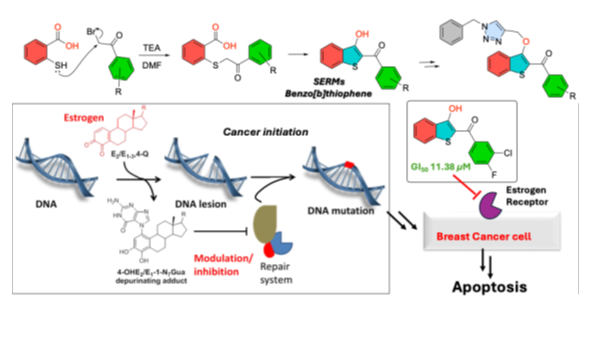
Discovering Etiology based Strategies for the Prevention and Treatment of Estrogen induced Breast Cancer
Abstract:
Breast cancer remains one of the most prevalent malignancies affecting women worldwide, with Pakistan reporting one of the highest incidence rates in Asia. Addressing this critical health challenge requires a multifaceted approach to integrate understanding the disease’s etiology with developing innovative therapeutic strategies. This PhD research lays the groundwork for such a comprehensive approach by investigating the molecular mechanism underlying the initiation of estrogen-induced breast cancer and advancing the therapeutic options. The study focuses on two main objectives: (1) exploring the role of estrogen metabolism to identify potential pathways involved in breast cancer initiation, and (2) designing and synthesizing novel drug molecules targeting estrogen receptors (ERs) to provide effective treatment for estrogen receptor-positive (ER+) breast cancers. In the first part, a chemical probe was synthesized to investigate how estrogen-depurinating adducts, formed by the reaction of estrogen-3,4-quinone with DNA, may cause cancer-specific mutations. The study employed affinity chromatography and molecular docking to demonstrate that certain proteins, involved directly or indirectly in DNA repair mechanisms, such as HDAC8, ATM, CHK1, CHK2, and SIRT2, have a strong affinity towards these adducts. In the second part, a pharmacologically privileged scaffold, benzothiophene, was constructed to discover novel selective estrogen receptor modulators (SERMs). Using an innovative one-pot method, 2-aroylbenzo[b]thiophen-3-ols were prepared and tested in cancer cell lines to assess their antiproliferative activities. The synthetic approach enabled structural diversification, adding a triazole scaffold via Click chemistry. Furthermore, with the help of density functional theory (DFT), the reaction mechanism and energy profile were studied. This work advances the understanding of estrogen-related carcinogenesis and expands the chemical toolkit for developing improved breast cancer therapies.
Graphical Abstract:

Final Thesis Defense Committee:
Dr. Muhammad Saeed, Department of Chemistry and Chemical Engineering/SBASSE, LUMS (Committee member, Supervisor)
Professor Irshad Hussain, Department of Chemistry and Chemical Engineering/SBASSE, LUMS (Committee member)
Dr Shaper Mirza, Department of Life Sciences, SBASSE, LUMS (Committee member, convener FDC)
Dr Muhammad Zaheer, Department of Chemistry and Chemical Engineering/SBASSE, LUMS (Committee member)
Dr. Muhammad Shoaib, Department of Life Sciences/SBASSE, LUMS (SSE Examiner)
Professor Muhammad Abbas, Department of Chemistry, FC College University, Lahore (External examiner)
List of Publications:
- Mukhtar, A.; Iftikhar, A.; Maqbool, M.; Faisal, A.; Ayub, K.; Saeed, M., Synthesis, mechanistic insights, and anticancer evaluation of novel 2-aroylbenzo[b]thiophen-3-ols: A DFT and Hirshfeld surface analysis. Journal of Molecular Structure 2024, 1324, 140802. https://doi.org/10.1016/j.molstruc.2024.140802
- Mukhtar, A.; Hussain, A.; Younas, F.; Yousuf, S.; Saeed, M., Facile synthesis of substituted 2-aroylbenzo [b] thiophen-3-ols to form novel triazole hybrids using click chemistry. RSC Advances 2024, 14 (15), 10270-10279. https://doi.org/10.1039/D4RA01146E
- Mukhtar, A.; Saeed, M., Determining the role of Estrogen DNA Depurinating adducts in the initiation and progression of breast cancer. (Manuscript in preparation)
- Lau, K. H. A.; Mukhtar, A., Multifunctional peptide biointerfaces. In Peptide Bionanomaterials: From Design to Application, Springer: 2023; pp 515-537. https://doi.org/10.1007/978-3-031-29360-3_15
- Saeed, A.; Ashraf, S.; Shabir, G.; Hökelek, T.; Floerke, U.; Mukhtar, A.; Saeed, M., Synthesis, X-Ray crystallography and HF/DFT analysis of N (diethylcarbamothioyl) furan-2-carboxamide, analyzed by experimental and theoretical methods. Journal of Molecular Structure 2022, 1268, 133721. https://doi.org/10.1016/j.molstruc.2022.133721
- Rahman, L.; Mukhtar, A.; Ahmad, S.; Rahman, L.; Ali, M.; Saeed, M.; Shinwari, Z. K., Endophytic bacteria of Fagonia indica Burm. f revealed to harbour rich secondary antibacterial metabolites. Plos one 2022, 17 (12), e0277825. DOI: 10.1371/journal.pone.0277825

